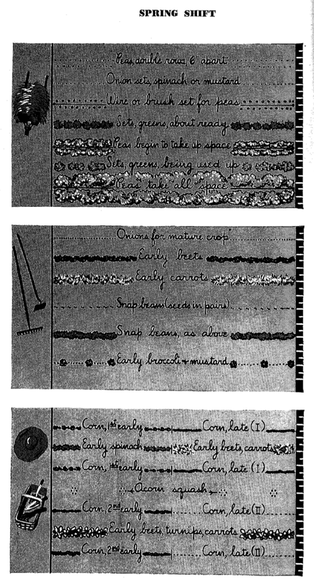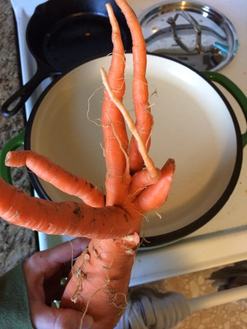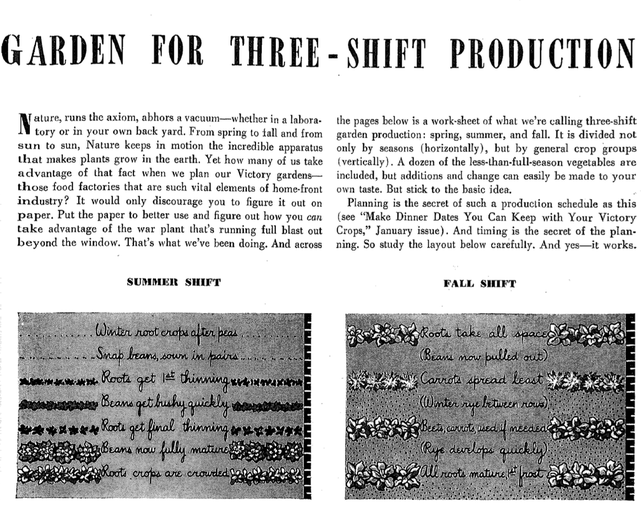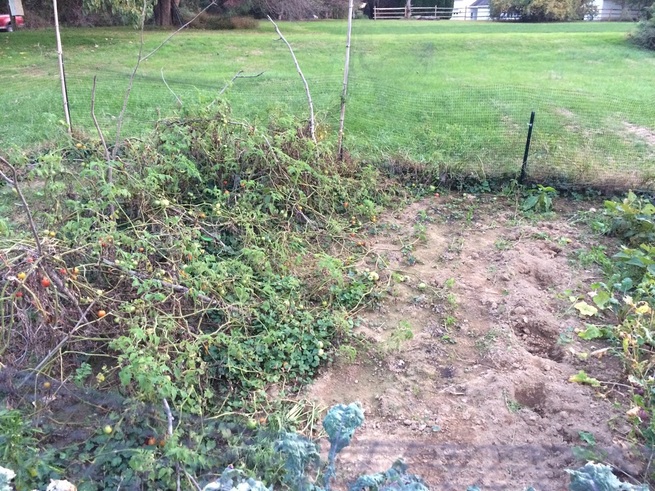Producing for Three-Quarters of the Year
Simply planting a garden is not enough! What was called for was continuous replanting; three full shifts of production for those who had the luxury of a long growing season: spring, summer, and fall. Not only is this imperative for getting the most out of your square feet by reusing the soil multiple times in a season, but it can be the only practical way to grow some vegetables: while eggplants and peppers thrive in the heat of midsummer, collard greens go to seed and grow bitter, and other brassicas simply fail to thrive.
Having gardened previously in the fine, but very cold, state of Wisconsin, I was determined to take full advantage of the extended, mild, mid-Atlantic growing season in Delaware -- but alas, we ran into some difficulties . . .
Rows Strike Again
 Spring Shift, ibid.
Spring Shift, ibid. Each crop has different dates when they can first go into the soil, and beyond that, different growth cycles and days to maturity. In our lettuce/radish row, for instance, lettuce reaches maturity in 45-55 days and can be selectively harvested for many days thereafter. However radishes can go from seed to harvest in as few as 20 days if you want them young and tender. Therefore, we couldn’t replace the whole row at once without letting the radish half lie fallow for a while. And trying to keep up with replacing such short-season crops as radishes can be exhausting because of how often you can replant them.
So why not replace them with something longer-slower growing after your first harvest you ask?
Well, you have to replace them with something that uses the same spacing scheme as what was in the former row. When you plant in rows for a small garden, as we did, each row is spaced differently because each contains different crops. The tomatoes needed a heck of a lot more room than the carrots, and carrots more room than the spinach. I couldn’t replace the radishes with broccoli or squash, because there wouldn’t have been nearly enough space.
Furthermore, you want to be sure that your succession crops are of a different family than the plant that preceded them in that patch of soil; that way, soil diseases, pests, and other nuisances are ‘kept on their toes’ as it were, by the continual variation.
Not a Pretty Garden Picture:
Solution: Plan Better!
 Lonely Brussel . . .
Lonely Brussel . . .
However, the embarrassing truth must be told. We didn’t plan for replanting mostly because the plan we selected didn’t do it for us; it didn't come with provisions for replanting and succession-planting. And I was cutting corners. I assumed that with the whole summer looming ahead of me, I’d have plenty of time to ‘figure it out’ on the fly. Not so.
So only at the very tail end Summer, the weather has been cool enough that the heat won’t stop our cool-weather crop seeds from germinating. But now I have fears that anything we start in the soil won’t have a long enough growing season to come to fruit before the first frosts hit – even with the unseasonable heat. It is quite the conundrum.
Plan, For the Remainder of the Season . . .
 MONSTER CARROT
MONSTER CARROT The name of the game for the rest of the season is slowly ripping out and harvesting everything we can, then replanting with a cover crop that will hopefully have time to germinate and become green manure over the winter, fixing nitrogen and replenishing the soil. To be frank, another major factor keeping us from doing more is simply that with the full onslaught of the semester -- visiting scholars and talks by friends, research trips, family visits, drafts due, grant and fellowship applications, and scheduling/preparing your own talks can make it difficult to do as much with the garden as you want to!


 RSS Feed
RSS Feed